Montana is home to a rich variety of wildlife, but some species are on the brink of being wiped out. These Montana endangered species are at risk of disappearing, emphasizing the importance of conservation efforts. Understanding these challenges is the first step towards protecting our natural heritage.
We will introduce the key endangered species in Montana, from Black-Footed Ferrets to Northern Long-Eared Bats. We’ll also cover some species that are under threat. Learn about the factors driving their decline, from habitat loss to human conflicts. Each species has a unique story that sheds light on the broader issue of wildlife conservation in Montana.
- Related article: Wildlife Watching in Montana
Have you ever wondered how you can help preserve Montana’s natural beauty and protect its endangered inhabitants? Our insights and tips on supporting conservation efforts might inspire you to take action. Together, we can make a difference and ensure these remarkable species continue to roam landscapes.
7 Key Takeaways on Endangered Species in Montana
- Endangered species are those close to extinction, while threatened species are at risk of becoming endangered soon. Currently, Montana has 6 endangered species and 4 other species under threat.
- Once thought extinct, the Black-Footed Ferret faces ongoing threats from habitat loss and introduced diseases. This highlights the impact of human activities on wildlife.
- The Least Tern’s struggle for survival is tied to man-made changes in river systems, emphasizing the need to protect natural waterways.
- The Northern Long-Eared Bat’s population decline, primarily due to white-nose syndrome, underscores the importance of addressing multiple threats to endangered species.
- The Pallid Sturgeon’s battle against habitat changes in the Missouri River serves as a call to balance development with environmental preservation.
- The White Sturgeon’s story in the Kootenai River reflects the ongoing challenges of pollution and dams in species recovery.
- The Whooping Crane’s successful population growth demonstrates the positive impact of dedicated conservation and offers hope for endangered species.
Endangered and Threatened Species: Know the Difference
| Aspect | Threatened Species | Endangered Species |
|---|---|---|
| Definition | A species likely to become endangered in the near future. | A species at the brink of extinction now or in the near future. |
| Risk Level | High risk of endangerment in the foreseeable future. | Extremely high risk of extinction in the immediate future. |
| Conservation Status | Less critical than endangered, but still requires protective measures. | Most critical, requiring urgent conservation measures. |
| Legal Protections | May vary. Generally involves some protective measures and monitoring. | Strong legal protections aimed at recovery and preventing extinction. |
| Examples of Actions | Habitat protection, legal restrictions on hunting and trade, monitoring programs. | Strict habitat preservation, breeding programs, stricter legal restrictions on hunting and trade. |
Understanding the difference between endangered and threatened species is key to grasping Montana’s wildlife challenges.
Endangered species are those on the brink of extinction, with so few left that they’re in immediate danger of disappearing. On the other hand, threatened species risk becoming endangered in the near future across a significant part of their home.
The distinction goes beyond how close these plants and animals are to the edge. It also affects how we legally protect them and our strategies to keep their populations healthy.
Both types of species need our help, but understanding these distinctions is vital for crafting effective conservation plans. This knowledge guides us on the level of protection and the kind of support each species requires to thrive.
Endangered Species in Montana

Montana’s wide-open spaces are home to various lives, but some creatures struggle to survive. These species are at risk of extinction, and the Fish and Wildlife Service (FWS) is the federal agency responsible for enforcing the Endangered Species Act.
We will examine the state’s threatened and endangered species fighting to survive. This glimpse into their world is a call to understand and protect our natural neighbors.
1. Black-Footed Ferret
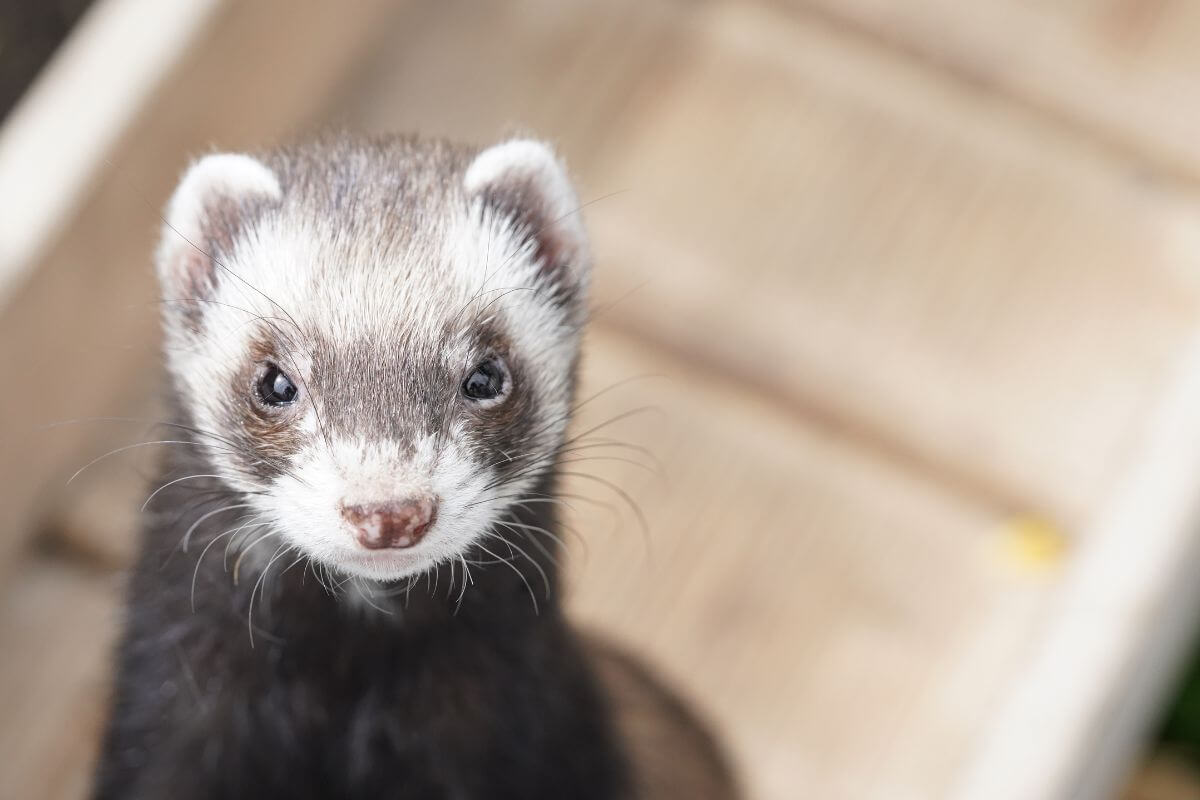
| Attribute | Value |
|---|---|
| Scientific Name | Mustela nigripes |
| Year Endangered | 1979 |
The Black-Footed Ferret, a small two-pound weasel, is a poignant example of a species on the edge of existence. It is the rarest mammal in North America, even after 29 years of being classified as endangered. This ferret’s story is heartbreaking, marked by steep declines in populations due to human activities.
In the early 1900s, the United States was home to over 5 million Black-Footed Ferrets. Today, it’s a different story. Introduced diseases and a long history of prairie dog control have pushed this species to the brink. Why prairie dogs? Because the ferrets depend on them entirely. They live in the burrows of prairie dogs and feed on them for survival.
The brink of extinction of the Black-Footed Ferret is a cautionary tale about how agricultural changes and the use of poisons can have unintended and devastating consequences. When prairie dogs were targeted and their populations were decimated by rodenticides, the ferrets suffered greatly. This led to events that saw the ferret’s numbers plummet.
In 1978, the death of the last known ferret in captivity led many to believe the species was forever lost. It’s a miracle that some were found in the wild, sparking efforts to save them. These remarkable creatures have a glimmer of hope thanks to dedicated conservation work.
2. Least Tern
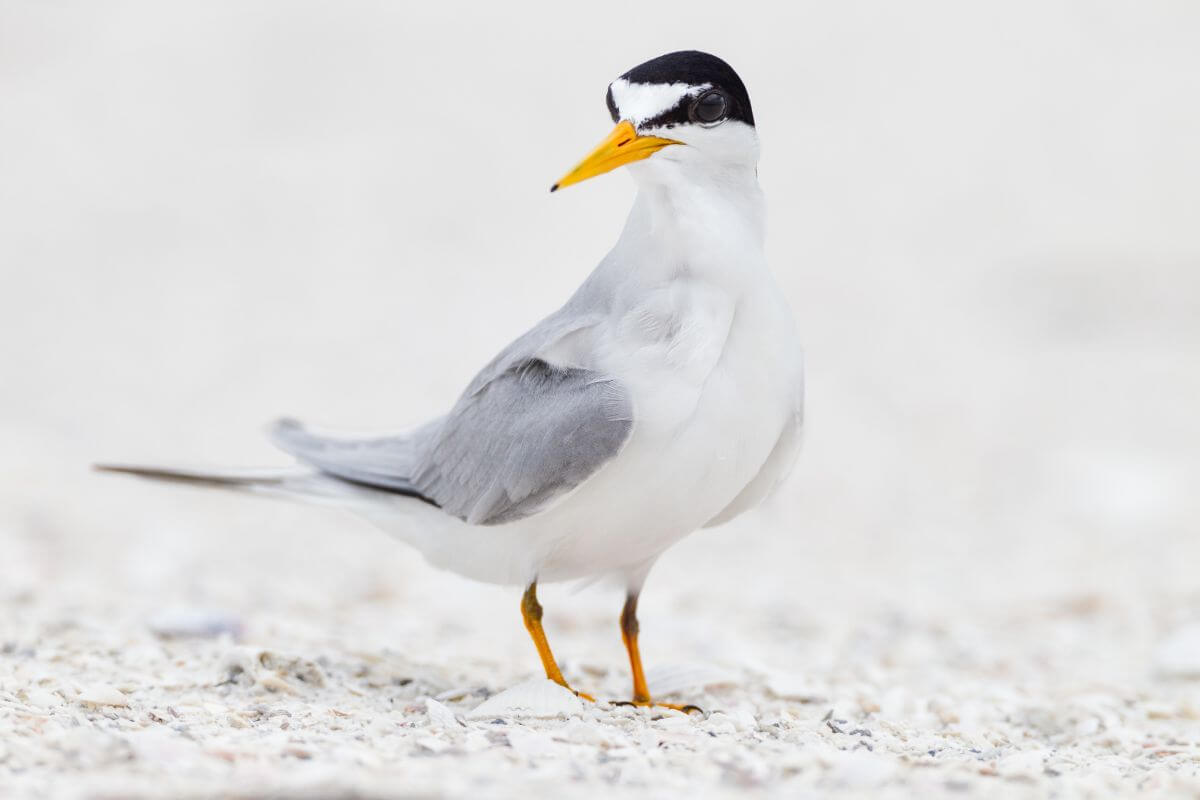
| Attribute | Value |
|---|---|
| Scientific Name | Sterna antillarum |
| Year Endangered | 1972 |
Despite its name, the Least Tern is a giant in the struggle for survival. This tiny bird, measuring 8 to 9 inches, faces big challenges. Back in 1985, the interior population of the Least Tern was declared endangered. This was a tough blow for a bird that thrives on change, evolving to cope with the ever-shifting rivers of Central America.
Key facts about the Least Tern:
- Size – Least Tern is the smallest in North America.
- Habitat – Least Tern nests in small groups on sandbars and shorelines.
- Feeding – Least Tern loves water and dives to catch fish.
The Least Tern is a creature of habit when it comes to nesting. You’ll find them in cozy groups on barren sandbars. These spots along rivers and shorelines are perfect for a tern family. The parents can be seen hovering over the water, ready to dive and catch fish. It’s a living thing that depends on water, which has become a problem.
Man-made changes to rivers have hit the Least Tern hard. Dams, reservoirs, and changing water flow have made life difficult. This is a classic case of human activity disrupting nature. Due to these habitat changes, the Least Tern is now in a “special concern” category.
So, remember the Least Tern the next time you see a small bird diving for fish. It symbolizes the importance of protecting natural habitats and letting rivers flow as they should.
3. Northern Long-Eared Bat
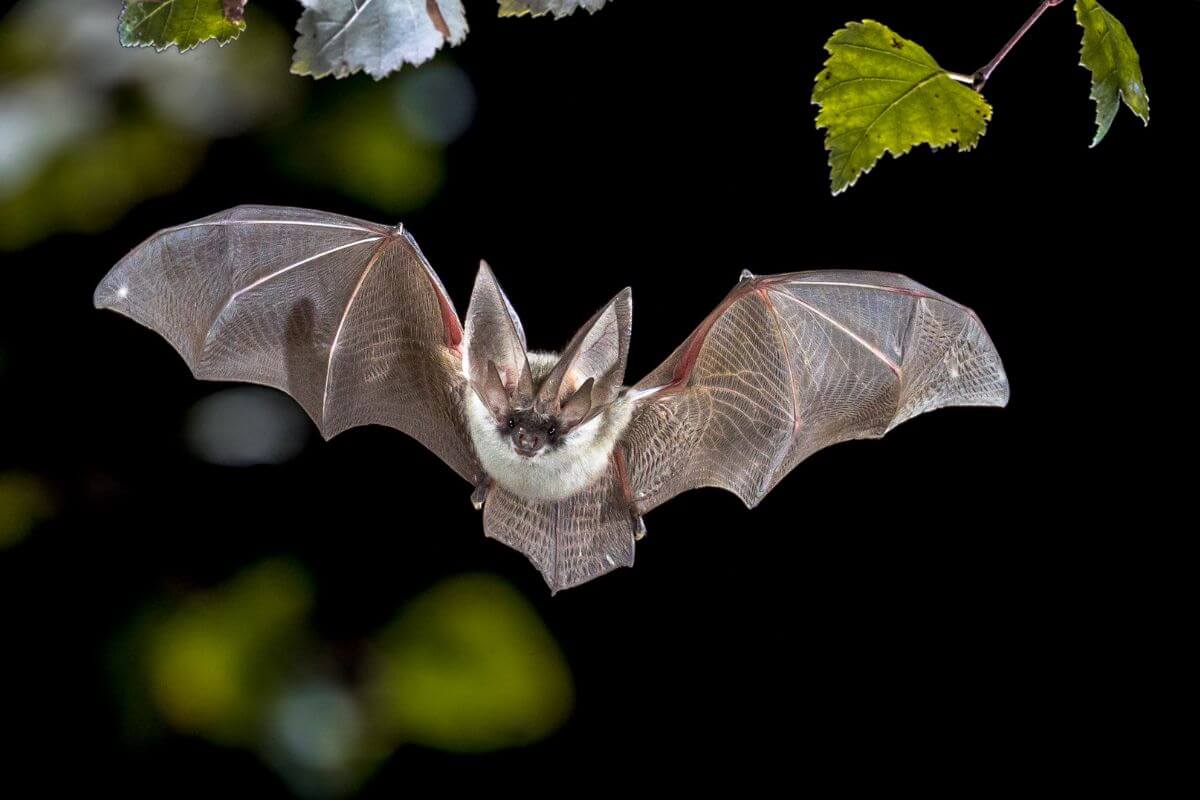
| Attribute | Value |
|---|---|
| Scientific Name | Myotis septentrionalis |
| Year Endangered | 2023 |
The Northern Long-Eared Bat, a vital part of Montana’s biodiversity, faces a substantial threat. This bat is one of 15 bat species in Montana and plays a crucial role in the ecosystem by naturally controlling pest populations.
However, the Northern Long-Eared Bat’s numbers have plummeted due to white-nose syndrome, a disease that has decimated bat populations across North America. This cold-adapted fungus-based illness affects bats during hibernation, leading to a greater than 90% decline in the Northern Long-Eared Bat population.
Because of these significant challenges, the Northern Long-Eared Bat was classified as Threatened in 2015 and Endangered in 2023 under the Endangered Species Act. This recognition highlights the urgent need to address this species’ various threats, including more than just white-nose syndrome.
Forest fragmentation, mining, logging, pesticides, and agricultural developments all contribute to the risks faced by this forest-dwelling creature.
It’s important to understand that protecting the Northern Long-Eared Bat isn’t just about saving a species. It’s about maintaining the balance of nature and safeguarding the services these bats provide. In particular, their vital role in pest control for agriculture.
4. Pallid Sturgeon

| Attribute | Value |
|---|---|
| Scientific Name | Scaphirhynchus albus |
| Year Endangered | 1990 |
The Pallid Sturgeon is a remarkable creature that tells a tale of struggle against the odds. Here are some key facts about the Pallid Sturgeon:
- Size and History – The Pallid Sturgeon is the largest of the two sturgeons that historically inhabited the upper Missouri River. The other, more common one, is the shovelnose sturgeon.
- Late Recognition – The Pallid Sturgeon was not identified as a separate species until 1905. The debate on its classification is still ongoing. So far, three genetic studies aimed at clarifying this have led to no clear conclusions.
- Diet and Lifespan – Known as bottom dwellers, these giants feed mainly on small fish and aquatic insects. The Pallid Sturgeon can live up to 50 years.
- Challenges Faced – Despite their resilience, changes to the water flow due to human activities like river channelization and the building of impoundments have severely impacted them. This has led to a significant reduction in their food sources, destroyed their spawning areas, and created obstacles to their movement in the Missouri and Yellowstone rivers. This highlights the importance of protecting their critical habitat.
The story of the Pallid Sturgeon is a call to action. It shows us the critical need to balance our development activities with preserving natural habitats.
5. White Sturgeon
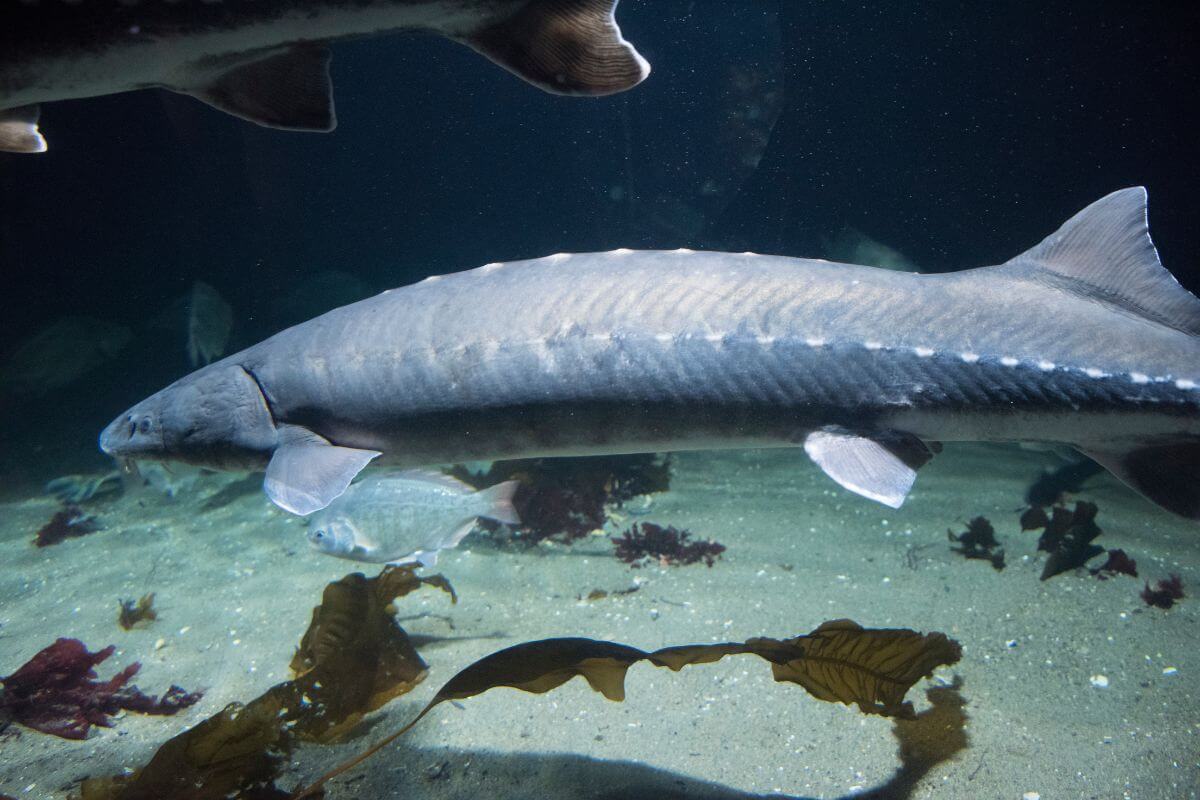
| Attribute | Value |
|---|---|
| Scientific Name | Acipenser transmontanus |
| Year Endangered | 1994 |
The White Sturgeon of the Kootenai River tells a story of survival against the odds. Back in 1994, this remarkable fish was labeled as endangered. Imagine a species swimming in these waters for centuries, struggling to survive. What caused this? The tale is as old as time but with a modern twist.
For over 40 years, the White Sturgeon population has been on a downward spiral. Natural reproduction has been almost non-existent since 1974. The 1950s and 1960s saw the beginning of the end for these majestic creatures. Pollution crept into the water, and the sturgeon started to disappear.
In 1972, the story took a darker turn with the building of Libby Dam. This wasn’t just a dam, it was a barrier to life. The water temperature changed, and river flow became artificial. Imagine being forced to lay your eggs in the sand, knowing they’ll never hatch. The sturgeon faced that as their eggs got buried and drifted away.
But, there’s hope in this story. Thanks to places like the Kootenai Tribal Sturgeon Hatchery, thousands of eggs have a chance. People fight to save them, raising the fragile eggs until they’re strong enough to survive in the wild.
Another ray of hope? Fishing for sturgeon is now off-limits in Montana. This ban is like a ‘keep out’ sign that gives the sturgeon space to navigate the river safely.
So, the White Sturgeon’s tale is a mix of old threats and new solutions. It reminds us that even the biggest, toughest creatures need our help to survive.
6. Whooping Crane
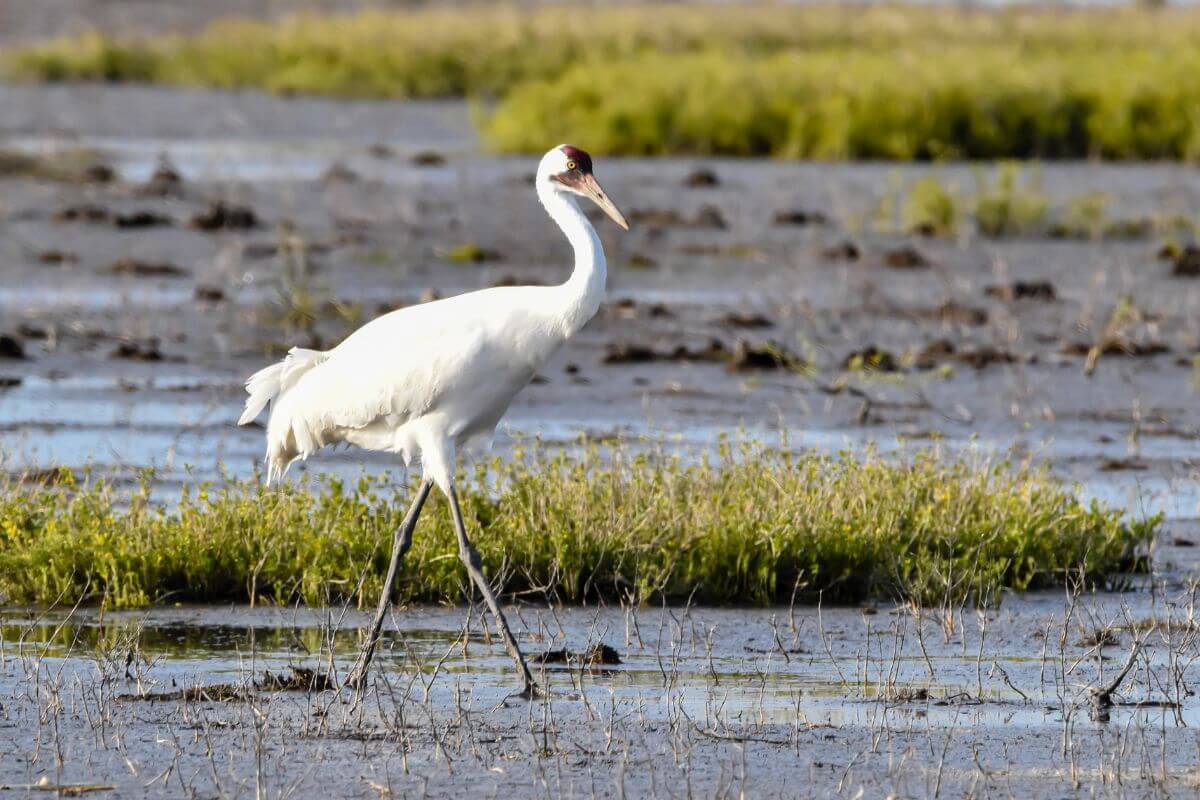
| Attribute | Value |
|---|---|
| Scientific Name | Grus americana |
| Year Endangered | 1967 |
The Whooping Crane is a true marvel of nature, and its story is one of both struggle and hope. Recognized as the tallest bird in North America, this bird has a wingspan of over 7 feet and stands 5 feet tall. Its distinctive call that echoes for miles sets it apart even more, making it recognizable in the vast skies.
Here are key facts about the Whooping Crane:
- Population – The world’s Whooping Crane population has reached 319, marking the highest level in a century. This increase is a beacon of success for conservation efforts. A significant part of this population or 190 individuals forms the only self-sustaining group in the wild. The group spends its winters at the Aransas National Wildlife Refuge in Texas.
- Migration – The Whooping Crane journey between Canada and Texas is no small feat. It includes stops in eastern Montana, particularly at the Medicine Lake and Red Rock Lakes National Wildlife Refuges. Though essential for survival, this migration exposes them to various risks. These include diseases and human-made dangers like powerlines.
- Unique Presence – The Whooping Crane is one of only two species native to North America, and its existence is crucial. This uniqueness highlights the importance of protecting its habitats and ensuring safe migration routes.
The success of the Whooping Crane’s story is a testament to the power of conservation. It shows that we can save endangered species and help their populations grow with dedicated efforts. This success motivates us to continue protecting all endangered species, ensuring a rich and diverse natural world.
4 Species Under Threat in Montana
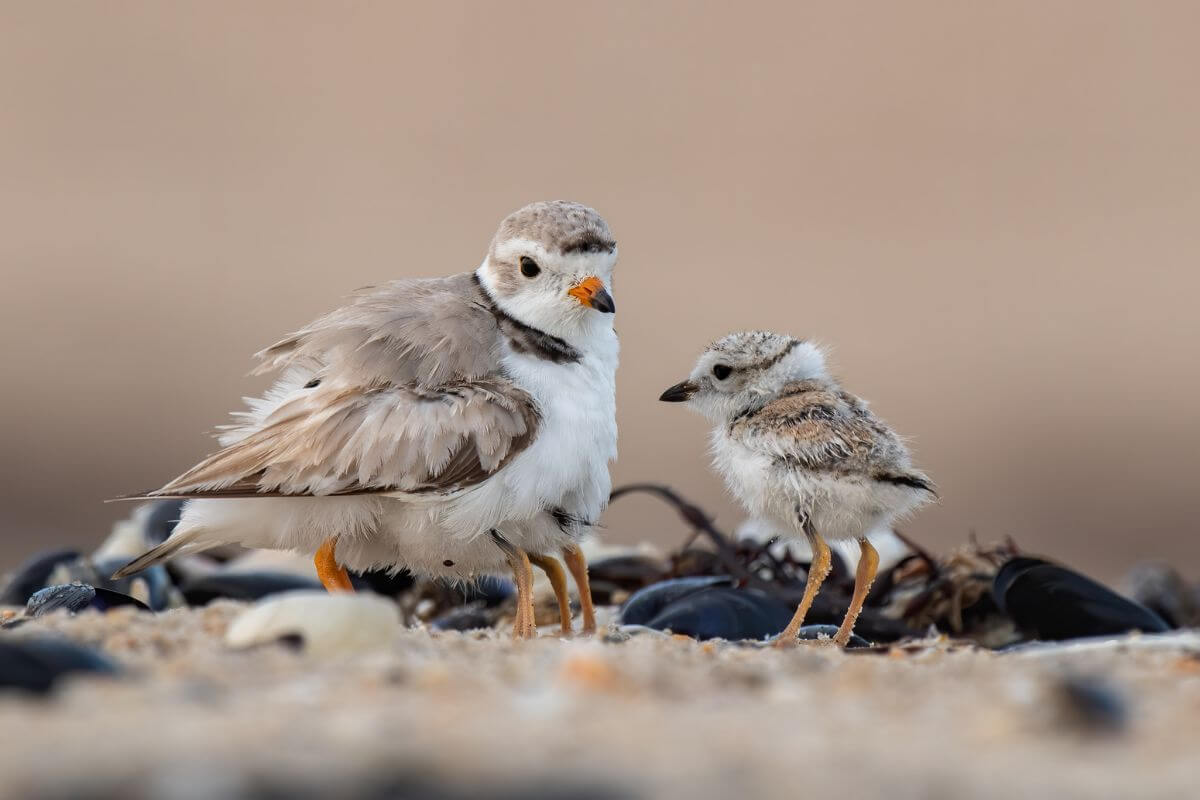
Montana’s diverse natural landscapes are home to many wildlife species, some of which could become endangered in the near future. We will examine four threatened individual species, understand their challenges, and explain why they’re important to the state’s ecosystem.
1. Bull Trout

| Attribute | Value |
|---|---|
| Scientific Name | Salvelinus confluentus |
| Year Threatened | 1998 |
A native of Montana, Bull Trout is facing tough times. These fish are not just any trout found in the Clark Fork and Flathead drainages of Western Montana. They’re a threatened species. Why? Their homes are changing, and they’re under attack from various angles.
Habitat loss is a big issue for the slowly declining population trend of Bull Trout. This is due to barriers like the Milltown dam, which cut them off from each other, making it hard to find new places to live.
In addition, they have picky tastes. They need their spawning streams to be just right. High sediment levels, like dirt and sand, can be deadly for their babies. It’s like trying to breathe with dirt on top of you. This is a major reason why their numbers are going down.
To make matters worse, some other fish, like the brook trout, move in on their turf. These new fish eat their food and take their homes. It’s a tough world out there for the Bull Trout.
But all hope is not lost. Montana has a habitat conservation plan to help the Bull Trout centering on efforts to stop poaching or illegal fishing and helping people tell the Bull Trout apart from others.
So, if you’re considering fishing in Montana, remember the Bull Trout. Check the rules on the Montana Fish, Wildlife, and Parks website. It’s a small step that can make a big difference in protecting these amazing fish.
2. Canada Lynx
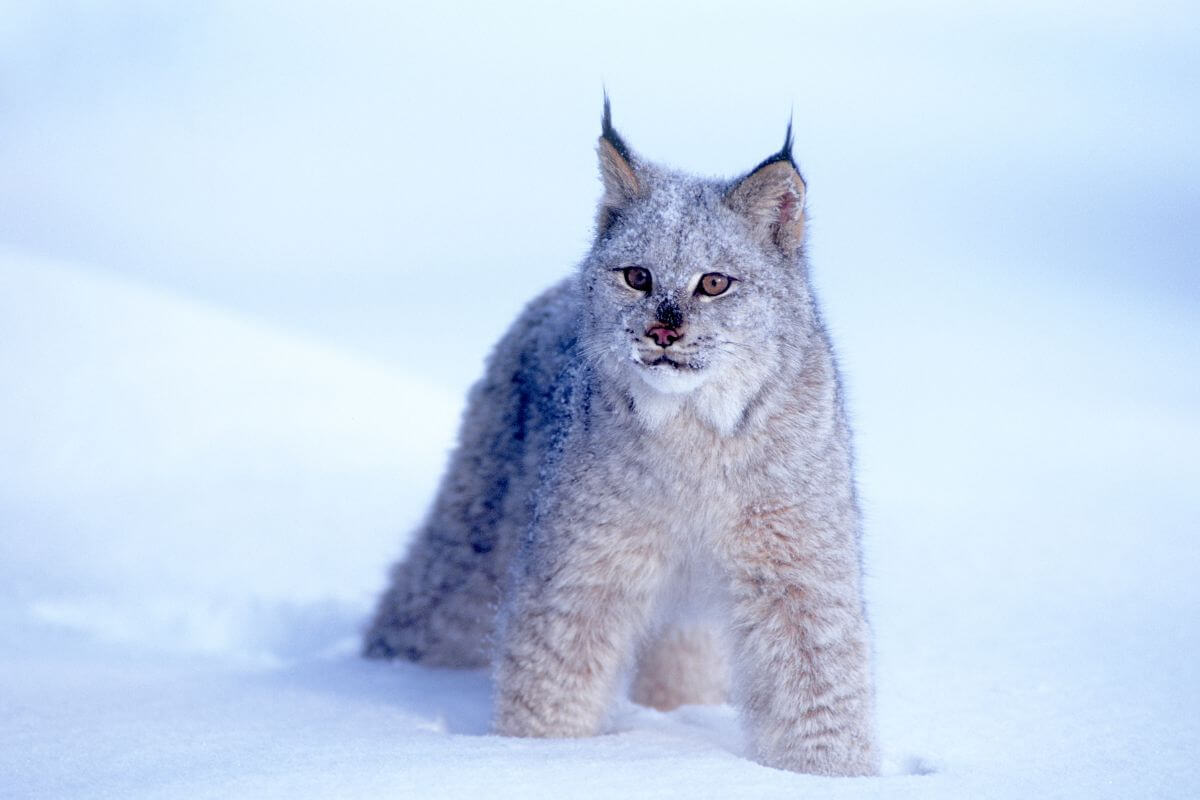
| Attribute | Value |
|---|---|
| Scientific Name | Lynx canadensis |
| Year Threatened | 2000 |
A symbol of wild beauty and grace, the Canada Lynx faces tough times. Back in the early 2000s, it was declared “threatened” by the U.S. Fish & Wildlife Service under the federal Endangered Species Act. This protection umbrella covers 16 states, Montana included. That means it’s illegal to trap or shoot a lynx in these areas.
People hunted lynx for their soft, thick, and valuable fur for a long time. Even though hunting lynx has been off-limits since 2015, lynx still get caught in traps meant for other animals. This accidental trapping adds to the challenges the lynx already faces.
Having your home shrink or change every year — that’s what’s happening to the lynx. Habitat loss is a big issue. Places where they used to roam freely are now forests being cut down, land being dug up for mines, or areas where people build houses and roads.
Among the human-made problems the lynx faces include:
- Winter Activities – Snowmobiling and skiing are cool for us but not for lynx. The noise and activity scare them away from the quiet they need.
- Climate Change – As the Earth heats up, so do the worries for the lynx. They’re built for cold climates and need deep snow to find food and raise their young. It’s a struggle for them when the snow isn’t deep enough.
The Canada Lynx is not just a beautiful animal, it’s a key part of our natural world. Protecting their biological features means looking out for the places they live and making sure those areas stay safe and untouched.
3. Grizzly Bear
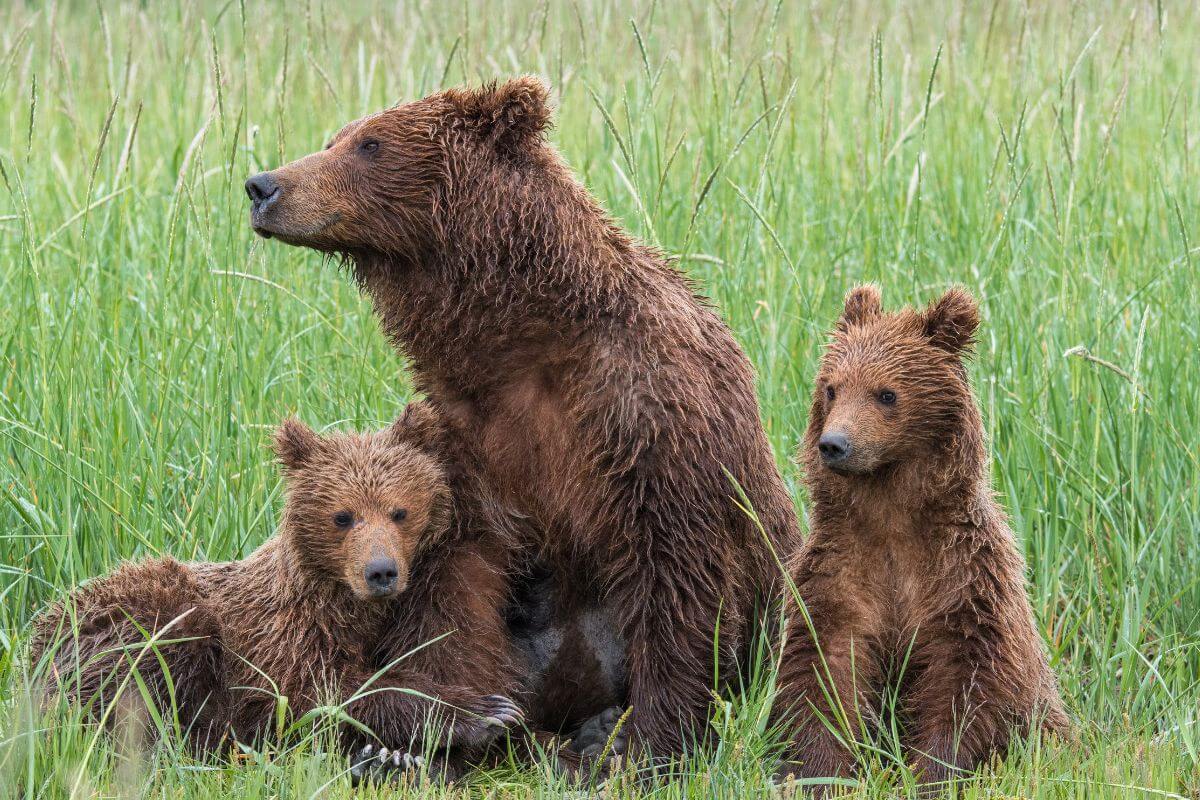
| Attribute | Value |
|---|---|
| Scientific Name | Ursus arctos horribilis |
| Year Threatened | 1975 |
As the powerful icons of the wilderness, Grizzly bears face a challenging future in Montana. Despite their strength, these creatures are vulnerable, especially to the changing climate.
In the coniferous forests of Western Montana, Grizzly bears find their home. Specifically, areas around the Bitterroot, Flathead, Kootenai, Lolo, and Deerlodge national forests are where these massive woodland mammals thrive. Yet, their habitat is under threat.
With global temperatures on the rise due to climate change, the grizzlies’ hibernation period is getting later. This means more encounters with hunters, hikers, and campers. Sadly, many grizzlies die during these times, forced to defend themselves.
Climate change impacts go beyond disturbing hibernation. It’s also changing what grizzlies eat. With their usual high-elevation food sources affected, grizzlies are coming down to areas where people live. This search for food leads them to places like farms and areas with lots of trash, putting them in conflict with humans.
Let’s look at the numbers to understand the scale of the issue. Grizzly bears are hard to count, but estimates from 2021 give us a picture:
| Ecosystem | Location | Estimated Bear Population |
|---|---|---|
| Northern Continental Divide Ecosystem | Montana | About 1,100 grizzlies |
| Yellowstone Ecosystem | Wyoming, Montana, Idaho | Around 1,000 bears |
| Selkirk Ecosystem | Idaho, Washington, British Columbia | Approximately 100 bears |
| Cabinet-Yaak Ecosystem | Montana, Idaho | Roughly 50 bears |
These numbers show that Montana is home to significant grizzly populations, making it a crucial state for conservation.
For grizzlies to survive and thrive, it’s not just about the vast forests and mountains. It’s also about working with everyone who shares the land, including private landowners. By understanding the challenges grizzlies face, we can all play a part in making sure these incredible animals have a future.
4. Piping Plover
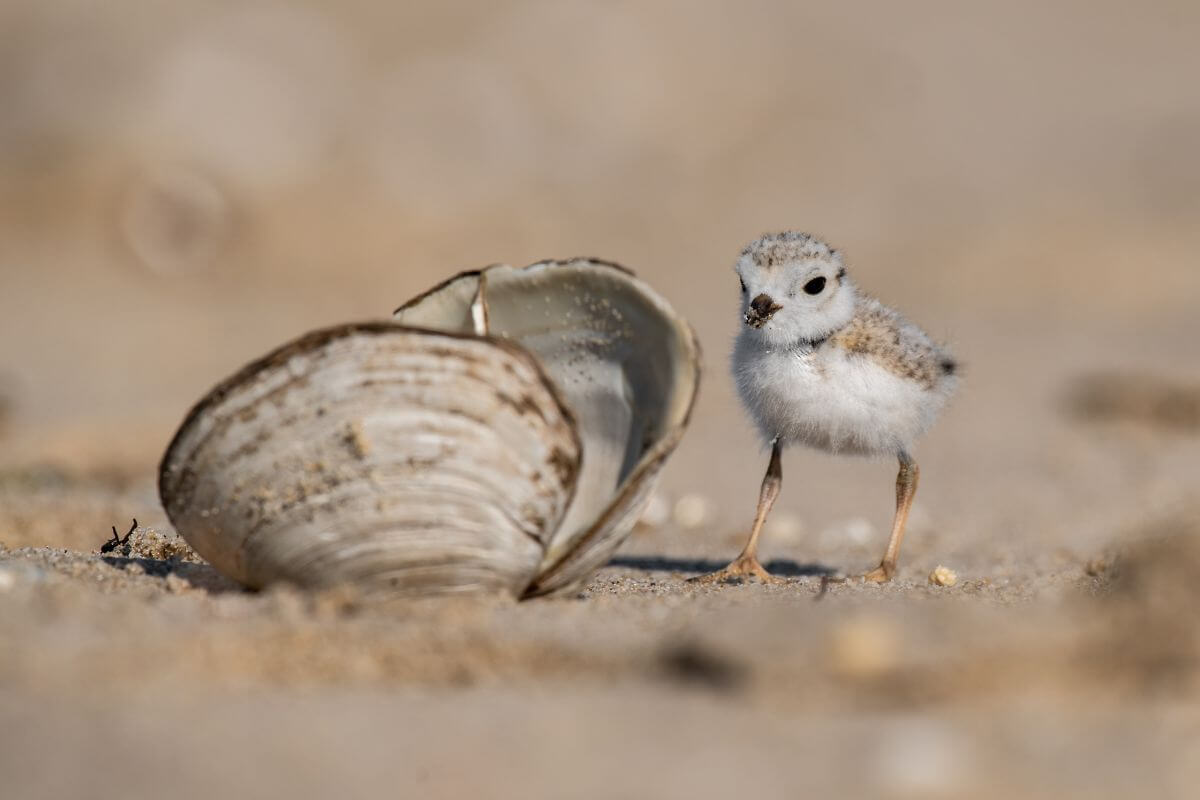
| Attribute | Value |
|---|---|
| Scientific Name | Charadrius melodus |
| Year Threatened | 1985 |
The Piping Plover is a tiny warrior, weighing only two ounces, that battles for survival in specific habitats. This shorebird is not just any bird, it’s a symbol of resilience in the face of extinction.
The Piping Plover is known for its choice of homes, including open beaches, alkali flats, and sandy areas. Now, these areas are not only for chilling in the sun, they have become battlegrounds where the Piping Plover fights for its future.
Here’s the deal with the Piping Plover’s address. It picks spots along the Atlantic coast from southern Canada to North Carolina for summer chilling.
When winter comes, it heads to the northern Great Plains, hanging out along major rivers and wetlands from southern Saskatchewan and Manitoba through Nebraska. It also frequents parts of the western Great Lakes during this time.
This brave bird settles in the northeastern corner of Montana. It arrives early in May and departs promptly by late August. While here, you’ll spot the Piping Plover relaxing by lakes, reservoirs, and rivers. But here’s the catch, these nesting spots often lead to problems, particularly for us humans.
The Piping Plover isn’t just trying to find a good spot on the beach. It’s fighting against things that can wipe it out, like off-road vehicles. These big trucks can crush nests and birds, putting the Plover’s babies in danger. It’s really hard for Piping Plover babies to find food when these vehicles are around.
This struggle is real because the Piping Plover has a limited distribution. It can only live in certain places. If we’re not careful, those places might not be around for much longer. It’s like having a favorite shirt that’s getting old. You need to take extra care of it if you want it to last.
So, remember the Piping Plover the next time you hit the beach or the shore of a lake. Look for signs telling you to watch your step. We can all do our bit to ensure this tiny bird with a big fight stays around for a long time.
Montana Endangered Species Final Thoughts
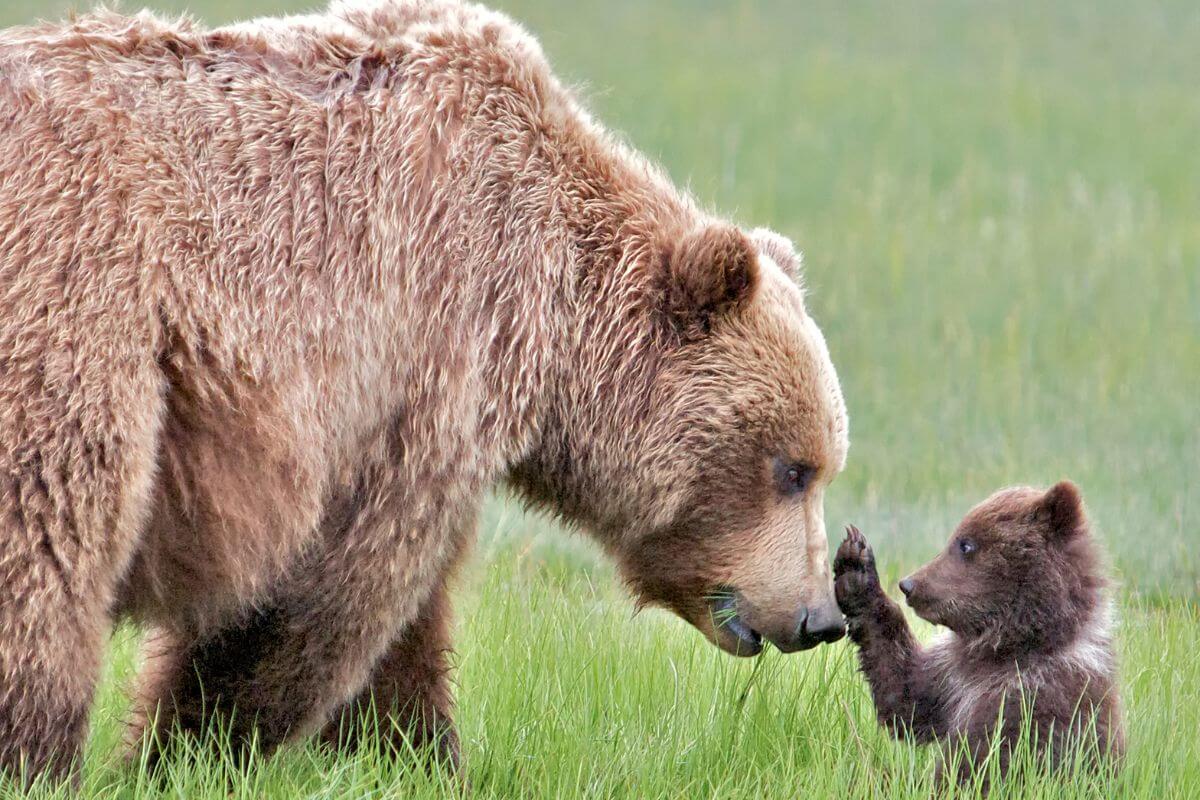
The stories of endangered species in Montana are more than just tales of struggle, they are calls to action. Each narrative reveals the fine balance between nature and the impact of human presence.
From the Black-Footed Ferret to the Whooping Crane, these creatures face unique challenges that echo broader conservation needs. Their fates are intertwined with our willingness to preserve natural habitats and rethink our approaches to coexistence.
As we reflect on these threatened and endangered species, we’re reminded of the urgent need for continued conservation efforts. The successes, like the growth of the Whooping Crane population, show that our dedication can make a difference.
We must ensure that future generations can still marvel at Montana’s wildlife diversity. Let’s take inspiration from these stories to advocate for and protect all species at risk, securing a harmonious future for both wildlife and people.
Montana Endangered Species FAQs
1. Are There Any Endangered Species in Montana?
Montana has 6 endangered animal species and 3 endangered plant species, including Spalding’s Campion, Water Howellia, and Ute Ladies’ Tresses.
2. Are Wolverines Endangered in Montana?
Wolverines were nearly extinct in Montana during the early 1900s, but their numbers and species range have steadily increased. Recovery efforts began in northwestern Montana and have gradually spread to cover their current range in the state.
Additionally, Montana Fish, Wildlife, and Parks have filed notice to sue over the listing of wolverines under the ESA. The state agency has threatened to take legal action against the U.S. Fish and Wildlife Service if it doesn’t reverse its decision made in November to list the animal as a threatened species.
3. Are Bears Endangered in Montana?
Bears, particularly grizzly bears, are threatened in Montana due to habitat loss and human conflicts. While efforts to conserve and manage bear populations have been ongoing, their status remains a concern in the state.
4. Are Moose Endangered in Montana?
Moose are not considered endangered in Montana, but their populations have declined in certain areas due to habitat loss, predation, and disease. Conservation efforts are in place to monitor and manage moose populations to ensure their long-term survival in the state.
5. Are Lynx Endangered in Montana?
Lynx are considered a species of concern in Montana due to declining prey populations, habitat fragmentation, and loss. While they are not listed as endangered in the state, conservation efforts are underway to monitor and protect lynx populations and their habitats.
More Montana articles await your curiosity:

